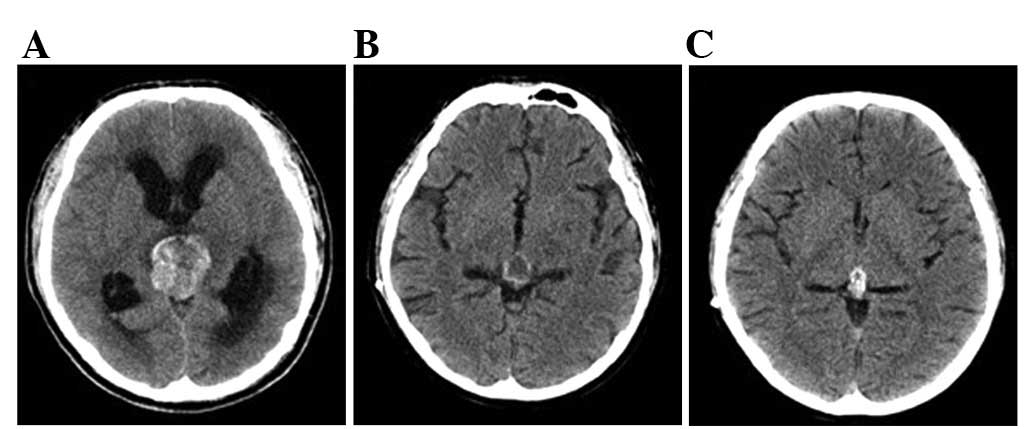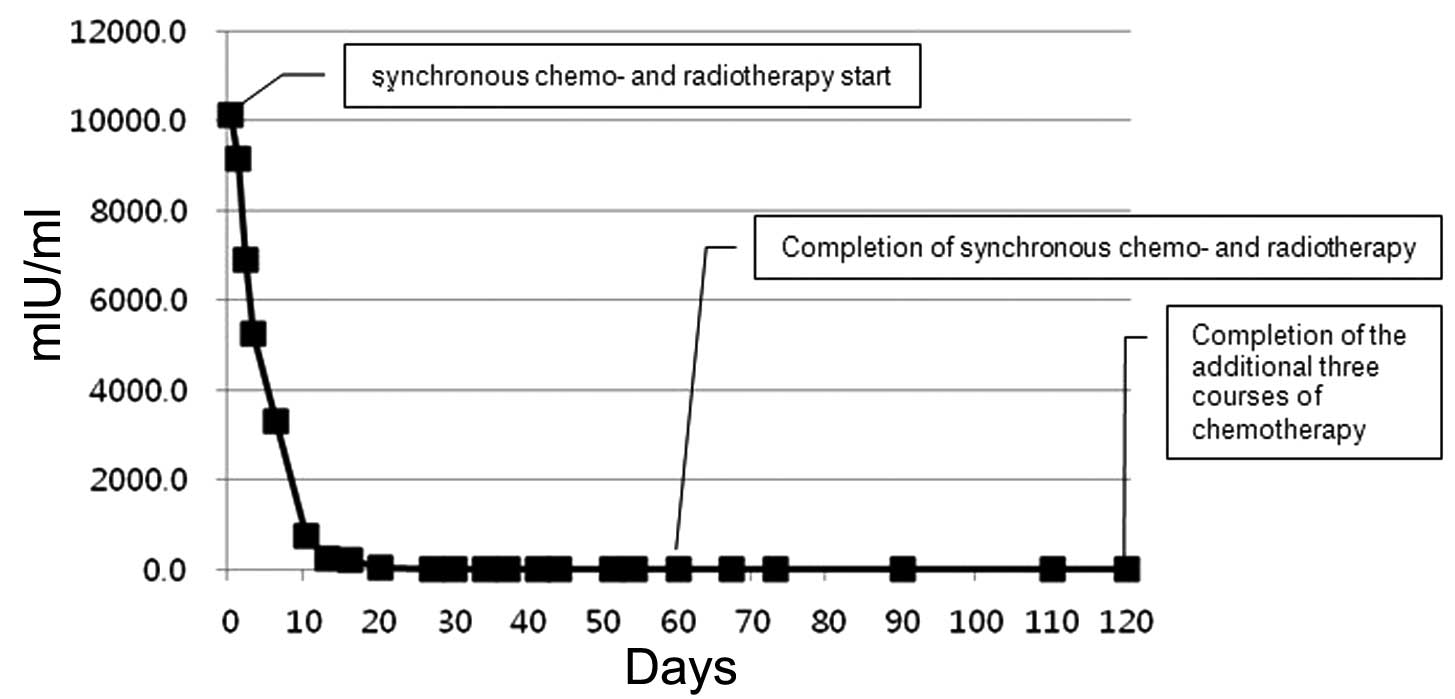Successful synchronous chemotherapy and radiotherapy followed by consecutive chemotherapy without surgery for primary intracranial choriocarcinoma: A case report
- Authors:
- Minjin Kim
- Jina Yun
- Soon Mi Hur
- Jong Joo Moon
- Jae Hyung Nam
- Se Hyung Kim
- Hyun Jung Kim
- Chan Kyu Kim
- Seong Kyu Park
- Dae Sik Hong
-
View Affiliations
Affiliations: Division of Hematology‑Oncology, Department of Internal Medicine, Soonchunhyang University School of Medicine, Bucheon University, Bucheon, Gyeonggi 420‑767, Republic of Korea
- Published online on: September 7, 2012 https://doi.org/10.3892/ol.2012.901
-
Pages:
1389-1391
Metrics:
Total
Views: 0 (Spandidos Publications: | PMC Statistics:
)
Metrics:
Total PDF Downloads: 0 (Spandidos Publications: | PMC Statistics:
)
This article is mentioned in:
Abstract
We experienced a rare case of primary intracranial choriocarcinoma treated successfully with synchronous chemotherapy and radiotherapy followed by three consecutive courses of chemotherapy without surgery. A 19‑year‑old male patient presented with a two‑week history of diplopia, headache, nausea and vomiting. Neurological examination revealed visual disturbance, bilateral hearing loss, bilateral sixth nerve palsy, left skew deviation, downgaze limitation and clockwise torsional nystagmus on the left upgaze. During image evaluation, the patient suddenly presented with a confused mental status, bradycardia and decreased respiration. An emergency third ventriculostomy was conducted, followed by synchronous ifosfamide, cisplatin and etoposide chemotherapy (ICE; I, 900 mg/m2; C, 20 mg/m2; and E, 60 mg/m2) on days 1‑5, and external radiotherapy (whole brain, 30 Gy/15 Fxs; local boost, 30 Gy/15 Fxs) followed again by three consecutive courses of chemotherapy. This therapy resulted in tumor regression by 63% and full improvement in the patient's neurological condition. However, it was difficult to remove the remaining tumor using a surgical approach due to the risk of postoperative hemorrhage and limited access. We planned to observe the remaining mass without surgery. This patient is now alive and the mass size has not changed for 18 months since treatment. This is the first report of the effectiveness of synchronous chemotherapy and radiotherapy followed by consecutive chemotherapy without surgery in a patient with primary intracranial choriocarcinoma.
View References
|
1.
|
J ShinodaN SakaiH YanoT HattoriA OhkumaH
SakaguchiPrognostic factors and therapeutic problems of primary
intracranial choriocarcinoma/germ-cell tumors with high levels of
HCGJ
Neurooncol66225240200410.1023/B:NEON.0000013499.74404.8115015791
|
|
2.
|
MT JenningsR GelmanF HochbergIntracranial
germ-cell tumors: natural history and pathogenesisJ
Neurosurg63155167198510.3171/jns.1985.63.2.01552991485
|
|
3.
|
M MatsutaniK SanoK TakakuraPrimary
intracranial germ cell tumors: a clinical analysis of 153
histologically verified casesJ
Neurosurg86446455199710.3171/jns.1997.86.3.04469046301
|
|
4.
|
M MatsutaniClinical management of primary
central nervous system germ cell tumorsSemin
Oncol31676683200410.1053/j.seminoncol.2004.07.01015497121
|
|
5.
|
The Committee of the Brain Tumor Registry
of Japan: Report of Brain Tumor Registry of Japan (1969–1993). 10th
editionNeurol Med Chir40Suppl1106200014705327
|
|
6.
|
Y KawakamiO YamadaK TabuchiT OhmotoA
NishimotoPrimary intracranial choriocarcinomaJ
Neurosurg53369374198010.3171/jns.1980.53.3.0369
|
|
7.
|
T FujiiT ItakuraS HayashiN KomaiH
NakamineK SaitoPrimary pineal choriocarcinoma with hemorrhage
monitored by computerized tomography. Case reportJ
Neurosurg55484487198110.3171/jns.1981.55.3.04847196441
|
|
8.
|
T KagejiS NagahiroK MatsuzakiSuccessful
neoadjuvant synchronous chemo- and radiotherapy for disseminated
primary intracranial choriocarcinoma: case reportJ
Neurooncol83199204200710.1007/s11060-006-9311-117205387
|
|
9.
|
H NittaJ YamashitaM NomuraN
IgarashiCervical spinal cord infarction after surgery for a pineal
region choriocarcinoma in the sitting position: case
reportNeurosurgery4010821085discussion10851086199710.1097/00006123-199705000-000399149270
|
|
10.
|
K TaomotoN TamakiY OboraK NakaiH
SatoIntracranial human chorionic gonadotropin producing tumors
(author’s transl)Neurol Med Chir (Tokyo)164114181976(In
Japanese).
|
|
11.
|
M MarxJD BeckGG GrabenbauerR FahlbuschHG
DörrGonadotrophin-independent puberty in a boy with a
beta-HCG-secreting brain tumourHorm Res544448200011182635
|
|
12.
|
AP KyritsisManagement of primary
intracranial germ cell tumorsJ
Neurooncol96143149201010.1007/s11060-009-9951-z19588227
|
|
13.
|
K SakuradaT KayamaK KawakamiM SainoS SatoA
successfully operated case of choriocarcinoma with recurrent
intratumoral hemorrhageNo Shinkei Geka2867722000(In Japanese).
|
|
14.
|
I YamamotoPineal region tumor: surgical
anatomy and approachJ
Neurooncol54263275200110.1023/A:101279021381811767292
|
|
15.
|
HS ChanRP HumphreysEB HendrickSH ChuangCR
FitzLE BeckerPrimary intracranial choriocarcinoma: a report of two
cases and a review of the
literatureNeurosurgery15540545198410.1227/00006123-198410000-000126541765
|











